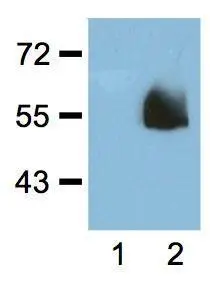
1:1000 (1microg/mL) Ab dilution probed against HEK293 cells transfected with HA-tagged protein vector; untransfected (1) and transfected (2)
HA tag antibody [HA.C5]
GTX18181
ApplicationsImmunoFluorescence, ImmunoPrecipitation, Western Blot, ELISA, ImmunoCytoChemistry, ImmunoHistoChemistry
Product group Antibodies
ReactivityOther Species
Overview
- SupplierGeneTex
- Product NameHA tag antibody [HA.C5]
- Delivery Days Customer9
- Antibody SpecificityRecognizes the N-terminal, C-terminal or internal HA-tagged fusion proteins
- Application Supplier NoteRecommended Starting Dilutions:WB (with ECL): Use at a dilution of 1:1000-3000 Immunostaining: Use at a dilution of 1:500 - 1:2000For best results with other assays (e.g.: Dot, ELISA, IP, etc), please determine optimal working dilution by titration test
- ApplicationsImmunoFluorescence, ImmunoPrecipitation, Western Blot, ELISA, ImmunoCytoChemistry, ImmunoHistoChemistry
- CertificationResearch Use Only
- ClonalityMonoclonal
- Clone IDHA.C5
- Concentration1 mg/ml
- ConjugateUnconjugated
- HostMouse
- IsotypeIgG3
- Scientific DescriptionThe HA tag is derived from an epitope of the influenza hemagglutinin protein, which has been extensively used as a general epitope tag in expression vectors.
- ReactivityOther Species
- Storage Instruction-20°C or -80°C,2°C to 8°C
- UNSPSC12352203
References
- HOPS, CORVET and newly-identified Hybrid tethering complexes contribute differentially towards multiple modes of endocytosis.Read more
- Single-Molecule Imaging Reveals How Mre11-Rad50-Nbs1 Initiates DNA Break Repair. Myler LR et al., 2017 Sep 7, Mol CellRead more
- A Cytoplasmic RNA Virus Alters the Function of the Cell Splicing Protein SRSF2. Rivera-Serrano EE et al., 2017 Apr 1, J VirolRead more
- Recruitment of Alix/AIP1 to the plasma membrane by Sendai virus C protein facilitates budding of virus-like particles. Irie T et al., 2008 Feb 5, VirologyRead more
